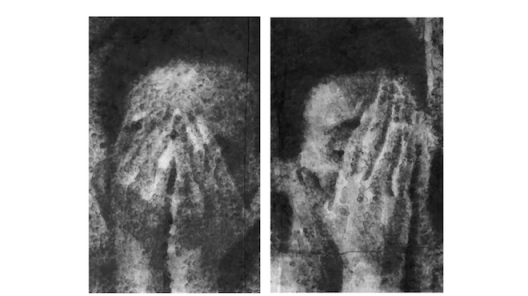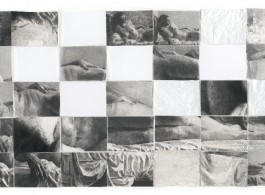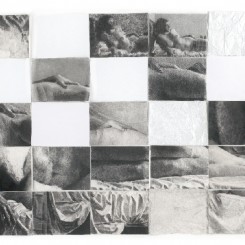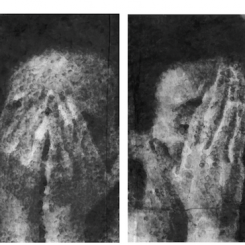Galerie Nathalie Obadia, Brussels
A brief description of the main characteristics of Jérôme Zonder’s production helps to explain the extent of the most recent developments in his new works, which are being shown for the first time today at the gallery of Nathalie Obadia in Brussels. Like all his past exhibitions, what strikes the eye and mind of the viewer first is the virtuoso talent of this draughtsman, as is demonstrated by the multiplicity of graphical registers employed in the different formats. We have already seen him utilize the clean lines typical of comic books, the elemental formation of drawings created using fingerprints, and the photographic realism of some of his large compositions, but what is much more characteristic of his manner is the encounter of his many “scripts” in the same space.
Using montage, Zonder combines different graphical systems on a single sheet of paper. The resulting complexity is all the more powerful. Emblematic of the image-based society we live in and sometimes debate, his motifs are variously borrowed from comics, splatter films, Walt Disney and his own photographs, at others gleaned from magazines or photographs of the Shoah or genocide in Rwanda, materials that were presented at his retrospective at the Maison Rouge in Paris in 2015. Zonder has always made use of this endless stratigraphy of images subjected to consumerist accumulation to the point of saturation. They are not ordered, let alone organized in a hierarchy. His graphical operations are far more interested in understanding what the effect of the images is and how they achieve that result.
The feeling of complete immersion created by the excess in the labyrinthine installation of his works at the Maison Rouge last year was representative of this omnipotence. The graphite applied with either a crayon or finger engendered a mise-en-abîme and evolved the drawing in the three-dimensional space. The degree of graphical intensity experienced by the viewer during the visit, and the increasing levels of saturation of grey and black, amplified what was literally at work in the framed drawings throughout the entire exhibition. As a result, paradoxically the drawing became unframed. Zonder harped on a theme dear to his heart: the exploration of limits. For example, adopting what was apparently the most extreme realism but at the same time taking illusionistic representation as far as it will go, Zonder traps the viewer, blurring the apparent and actual limits within which we think we see.
Indistinctiveness – a corollary of the notion of limits – is everywhere, demanding that the overly simplistic dichotomies by which we claim to govern the world are reconsidered. Zonder’s interlacing of narrations created from start to finish with the recurring iconic reappearances of the story probably contribute to the process. The same goes for the series of Jeux d’enfants and startling effects created by the random proximity of what he calls Fruits – small drawings that represent the intermediate stage between his initial documentation and his most complex compositions. We are conscious of the act of watching. Furthermore, we recognize that our gaze is completely subjective, full of pre-established ideas that we have to constantly be aware of, and even fight, to be able to establish a new way of thinking. That’s why the draughtsman employs the iconography of violence. He uses our fascination for it so as to better deconstruct it.
With the works presented today at the Brussels exhibition, whose installation arrangement – as usual long mulled over in Jérôme Zonder’s mind – is meaningful, the artist enters a new stage in his work, one that is of indisputable significance. The works are hung on the three levels of the gallery and their graphical complexity rises with the floor levels in the building. The title, Garance, will not be unknown to those who are familiar with Zonder’s production. With Baptiste and Pierre-François, Garance is one of the three characters who, with reference to the Enfants du Paradis by Marcel Carné, allows the artist to put into practice a “back-and-forth between history and representation”, between reality and fiction.
Dear to Zonder, the principle of interconnection is here taken to its limit.

From left to right : Portrait de Garance 11, 2015-2016, pencil lead and charcoal on paper, 64,1 x 45,5 x 3,5 cm (25 1/4 x 17 7/8 x 1 3/8 in.)
And Portrait de Garance 14, 2015-2016, pencil lead and charcoal on paper, 64,1 x 45,5 x 3,5 cm (25 1/4 x 17 7/8 x 1 3/8 in.)
The artist has followed the adventures of these three characters for some years already. They have grown along with his drawing. Still young only a short while ago, they have now passed out of adolescence and are gradually entering adulthood. Garance, now a young woman, reflects the maturity of Zonder’s drawing. He emphasizes the fact that the blooming of his subject is also the outcome of his encounter with the French photographer and militant feminist Julia Javel, who has become his model. This necessary otherness has made the regeneration of Garance possible while also fulfilling Zonder’s wish to draw the world we live in. He argues that using the narrative possibilities associated with a character opens a window of drawing possibilities where reality and representation work together. Here, too, forms of indistinctiveness introduce the notion of limits. Garance is a fiction in the real world just as much as she mixes reality with fiction.
In particular, the young woman’s history is about a search for identity, its construction and underlying paradoxes. The very many images in the exhibition linked to Garance are a reminder of the social injunction that says it is images that form us as individuals. The photographically realistic portraits on the ground floor offer a first level of interpretation. The question of the viewpoint and its relativity is first posed by the use of different scales and graphic variations on the paper. The latter undermine our confidence about what we think we saw at first glance. On the two upper floors, things become amazingly complicated. Ruptures occur and our understanding is thrown into turmoil by collisions of motifs, narrative violence and violence resulting from the different supports. Rather, it is the works that alarm the viewer. The two large grill-type structures restate the fragmentation of the Cubist plan while instilling real dynamism. The cinematic effect is striking and amplified by the resonance between the different graphic systems combined with the zones of black or white, silence and noise reunited. The grill both unifies and fragments at the same time. It denies all unequivocal understanding and re-establishes the cacophony of the world and ungraspable flow of time. Once again, we are conscious of seeing, partially of course, but actively.
This awareness of having an active attitude towards the image is a delight at a time of passivity generated by the chain of news stories on our virtual walls that run uniformly from the top downwards. The same critical operation is apparent in the large assemblages in which Garance is drawn surrounded by icons that both compose and are composed by her, uniting her many avatars and sources of inspiration. By combining different qualities of paper, supports and textures – Zonder calls them skins – the artist celebrates impurity to the detriment of the standardization of the images. Their supposed dematerialization is refuted by the assertion of the physical nature of drawing, which inscribes time in its meanders and overlays, and acts as a foil. All this by transcending his earlier works. The violence is no longer explicit but diffused. Similarly, the narrative contexts are more suggested than regulated, as they were in the past. Drawing supplants everything else. It generates a continuum that, through the flesh of the drawing itself, creates a bond between the flesh of the artist, conveyed through gesture, and that of the viewer. The process of drawing is more than ever present in his work. With this exhibition, Jérôme Zonder once again tackles the question of art as a mirror image of the world. His drawing scratches beneath the surface of the mirror in which our era is reflected, that of the betrayal of images.
Baptiste Brun, 26 mars 2016
Art critic
and lecturer-researcher in the history of contemporary art at the University of Rennes 2 (Rennes, France).
Born in Paris (France) in 1974, today Jérôme Zonder lives and works in the city.
A graduate of the École nationale supérieure des beaux-arts de Paris in 2001, for the past fifteen years Jérôme Zonder has elaborated a virtuoso practice centred on drawing. For the most part created using lead and charcoal, his works, which are often large in format, elicit both admiration and dismay in the viewer.
References in his work to Albrecht Dürer, Robert Crumb, Rembrandt, Philippe de Champaigne, Charles Burns and Otto Dix, as well as to the worlds of Walt Disney and Tintin, jostle one another in his often cruel narratives: “Narration draws us into a drawing, whereas the body alone keeps us on the surface. For me, drawing is a continual question of distance and proximity, figuration and abstraction, attraction and repulsion”.
He was given his first institutional solo exhibition at Le Lieu unique in Nantes (France) in 2014.
In spring 2015 La Maison Rouge – Fondation Antoine-de-Galbert in Paris (France) asked him to design the space so that the viewer would feel invited to enter into the drawing itself. Jérôme Zonder covered the floors and walls of the building to create a spatial and mental path that passed through his personal concerns.
This young French artist has received growing attention on the international scene for some years, as is evinced by his current participation in the exhibitions “Prière de toucher – Le tactile dans l’art”, at the Museum Tinguely in Basel (Switzerland) and “Portrait de L’artiste en alter” at the Frac Haute Normandie in Rouen (France).
In 2016 Jérôme Zonder will have three solo exhibitions: following his first solo exhibition at the Galerie Nathalie Obadia in Brussels, he will have shows at the Drawing Centre Diepenheim (Netherlands) and the RAM Galleri in Oslo (Norway).



